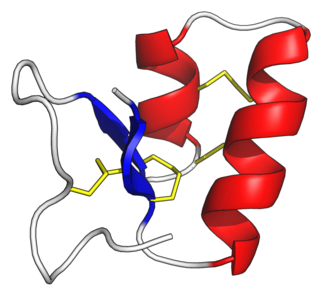Related Research Articles

Proinsulin is the prohormone precursor to insulin made in the beta cells of the islets of Langerhans, specialized regions of the pancreas. In humans, proinsulin is encoded by the INS gene. The islets of Langerhans only secrete between 1% and 3% of proinsulin intact. However, because proinsulin has a longer half life than insulin, it can account for anywhere from 5–30% of the insulin-like structures circulating in the blood. There are higher concentrations of proinsulin after meals and lower levels when a person is fasting. Additionally, while proinsulin and insulin have structural differences, proinsulin does demonstrate some affinity for the insulin receptor. Due to the relative similarities in structure, proinsulin can produce between 5% and 10% of the metabolic activity similarly induced by insulin.

Colostrum is the first form of milk produced by the mammary glands of mammals immediately following delivery of the newborn. Most species will begin to generate colostrum just prior to giving birth. Colostrum has an especially high amount of bioactive compounds compared to mature milk to give the newborn the best possible start to life. Specifically, colostrum contains antibodies to protect the newborn against disease and infection, and immune and growth factors and other bioactives that help to activate a newborn’s immune system, jumpstart gut function, and seed a healthy gut microbiome in the first few days of life. The bioactives found in colostrum are essential for a newborn’s health, growth and vitality.

Lactoferrin (LF), also known as lactotransferrin (LTF), is a multifunctional protein of the transferrin family. Lactoferrin is a globular glycoprotein with a molecular mass of about 80 kDa that is widely represented in various secretory fluids, such as milk, saliva, tears, and nasal secretions. Lactoferrin is also present in secondary granules of PMNs and is secreted by some acinar cells. Lactoferrin can be purified from milk or produced recombinantly. Human colostrum has the highest concentration, followed by human milk, then cow milk (150 mg/L).

Defensins are small cysteine-rich cationic proteins across cellular life, including vertebrate and invertebrate animals, plants, and fungi. They are host defense peptides, with members displaying either direct antimicrobial activity, immune signalling activities, or both. They are variously active against bacteria, fungi and many enveloped and nonenveloped viruses. They are typically 18-45 amino acids in length, with three or four highly conserved disulphide bonds.

Antimicrobial peptides (AMPs), also called host defence peptides (HDPs) are part of the innate immune response found among all classes of life. Fundamental differences exist between prokaryotic and eukaryotic cells that may represent targets for antimicrobial peptides. These peptides are potent, broad spectrum antibiotics which demonstrate potential as novel therapeutic agents. Antimicrobial peptides have been demonstrated to kill Gram negative and Gram positive bacteria, enveloped viruses, fungi and even transformed or cancerous cells. Unlike the majority of conventional antibiotics it appears that antimicrobial peptides frequently destabilize biological membranes, can form transmembrane channels, and may also have the ability to enhance immunity by functioning as immunomodulators.

Transfer factors are essentially small immune messenger molecules that are produced by all higher organisms. Transfer factors were originally described as immune molecules that are derived from blood or spleen cells that cause antigen-specific cell-mediated immunity, primarily delayed hypersensitivity and the production of lymphokines, as well as binding to the antigens themselves. They have a molecular weight of approximately 5000 Daltons and are composed entirely of amino acids. Transfer factors were discovered by Henry Sherwood Lawrence in 1954.
Iron-binding proteins are carrier proteins and metalloproteins that are important in iron metabolism and the immune response. Iron is required for life.
Cathelicidin antimicrobial peptide (CAMP) is a polypeptide that is primarily stored in the lysosomes of macrophages and polymorphonuclear leukocytes (PMNs); in humans, the CAMP gene encodes the peptide precursor CAP-18, which is processed by proteinase 3-mediated extracellular cleavage into the active form LL-37. LL-37 is the only peptide in the Cathelicidin family found in the human body.

Beta-defensin 2 (BD-2) also known as skin-antimicrobial peptide 1 (SAP1) is a peptide that in humans is encoded by the DEFB4 gene.

Granulysin (GNLY) is a protein expressed in most mammals which functions as an antimicrobial peptide released by killer lymphocytes in cytotoxic granules. It is a pore-forming peptide, as it can puncture a microbial cell wall, allowing for other death-inducing enzymes to enter the microbe and cause microptosis. GNLY is inhibited by cholesterol, and is most effective in helping to kill cholesterol-deficient microbes.
Lingual antimicrobial peptide (LAP) is a beta-defensin found in bovine internal epithelial tissue, in particular, that of the digestive tract. It has antimicrobial activity against many different pathogens. It was first isolated from an inflamed cattle tongue, hence its designation as lingual. Since then it has been found more extensively throughout the body; its presence has even been detected in bovine milk. Its expression is selective and increases in inflamed areas. LAP may have a closer relationship with immune response than simple antimicrobial activity, such as an association with growth factor activity.
Pseudin is a peptide derived from Pseudis paradoxa. Pseudins have some antimicrobial function.
Κ-casein, or kappa casein, is a mammalian milk protein involved in several important physiological processes. Chymosin splits K-casein into an insoluble peptide and water-soluble glycomacropeptide (GMP). GMP is responsible for an increased efficiency of digestion, prevention of neonate hypersensitivity to ingested proteins, and inhibition of gastric pathogens. The human gene for κ-casein is CSN3.

Donkey milk is the milk from the domesticated donkey (Equus asinus). It has been used since antiquity for cosmetic purposes as well as infant nutrition.
Feline coronavirus (FCoV) is a positive-stranded RNA virus that infects cats worldwide. It is a coronavirus of the species Alphacoronavirus 1 which includes canine coronavirus (CCoV) and porcine transmissible gastroenteritis coronavirus (TGEV). It has two different forms: feline enteric coronavirus (FECV) that infects the intestines and feline infectious peritonitis virus (FIPV) that causes the disease feline infectious peritonitis (FIP).

Thionins are a family of small proteins found solely in higher plants. Typically, a thionin consists of 45–48 amino acid residues. 6–8 of these are cysteine forming 3–4 disulfide bonds. Alpha- and beta- thionins are related to each other. The gamma thionins have a superficially similar structure but are an unrelated class of protein, now called plant defensins.

Lactoperoxidase is a peroxidase enzyme secreted from mammary, salivary and other mucosal glands including the lungs, bronchii and nose that functions as a natural and the first line of defense against bacteria and viruses. Lactoperoxidase is a member of the heme peroxidase family of enzymes. In humans, lactoperoxidase is encoded by the LPO gene.

Amidorphin is an endogenous, C-terminally amidated, opioid peptide generated as a cleavage product of proenkephalin A in some mammalian species; in humans and most other species, the peptide is 1 residue longer and is not amidated. Amidorphin is widely distributed in the mammalian brain, with particularly high concentrations found in the striatum, and outside of the brain in adrenal medulla and posterior pituitary. The 26-residue peptide named amidorphin is found in several species including bovine, sheep, and pig. Humans and commonly studied lab animals produce a 27-residue peptide that does not have an amidated C-terminal residue; this is due to the absence of a Gly in the precursor sequence and replacement with Ala, which is not a substrate for the amidating enzyme. The properties of the 27-residue peptide are presumably similar to those of amidorphin, although this has not been adequately tested.
Amphibian antimicrobial peptides are a family of highly potent antimicrobial peptides with a large spectrum of activity, which are synthetized by vertebrates as an efficient host-defence mechanism against invading microorganisms. A number of these defence peptides are secreted from the skin of frogs and other amphibians, including the opiate-like dermorphins and deltorphins, and antimicrobial dermaseptins, temporins, bombinins, magainin, pseudin, bombesins, and maculatins.

Spooky toxin (SsTx) is a small peptide neurotoxin. It is found in the venom of Chinese red-headed centipedes, also known as golden head centipedes. It is originally composed of 76 amino acids, with a molecular weight of 6017.5 Daltons, but loses the first 23 residues and becomes 53 residues long. SsTx is currently thought to be unique to Scolopendra subspinipes mutilans.
References
- ↑ Wakabayashi H, Takase M, Tomita M (2003). "Lactoferricin derived from milk protein lactoferrin" (PDF). Current Pharmaceutical Design. 9 (16): 1277–1287. doi:10.1007/s13594-013-0153-2. PMID 12769736. S2CID 85279971.
- ↑ Eliassen LT, Berge G, Sveinbjørnsson B, Svendsen JS, Vorland LH, Rekdal Ø (2002). "Evidence for a direct antitumor mechanism of action of bovine lactoferricin". Anticancer Research. 22 (5): 2703–10. PMID 12529985.
- ↑ Théolier J, Fliss I, Jean J, Hammami R (2013). "MilkAMP: a comprehensive database of antimicrobial peptides of dairy origin" (PDF). Dairy Science & Technology. 94 (2): 181–193. doi:10.1007/s13594-013-0153-2. PMID 12769736. S2CID 85279971.
- ↑ Bruni, Natascia; Capucchio, Maria Teresa; Biasibetti, Elena; Pessione, Enrica; Cirrincione, Simona; Giraudo, Leonardo; Corona, Antonio; Dosio, Franco (2016-06-11). "Antimicrobial Activity of Lactoferrin-Related Peptides and Applications in Human and Veterinary Medicine". Molecules. 21 (6): 752. doi:10.3390/molecules21060752. ISSN 1420-3049. PMC 6273662 . PMID 27294909.
- ↑ Gifford JL, Hunter HN, Vogel HJ (November 2005). "Lactoferricin: a lactoferrin-derived peptide with antimicrobial, antiviral, antitumor and immunological properties". Cellular and Molecular Life Sciences. 62 (22): 2588–98. doi:10.1007/s00018-005-5373-z. PMID 16261252.
- ↑ Hunter HN, Demcoe AR, Jenssen H, Gutteberg TJ, Vogel HJ (August 2005). "Human lactoferricin is partially folded in aqueous solution and is better stabilized in a membrane mimetic solvent". Antimicrobial Agents and Chemotherapy. 49 (8): 3387–95. doi:10.1128/AAC.49.8.3387-3395.2005. PMC 1196233 . PMID 16048952.